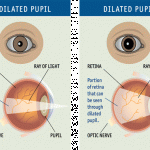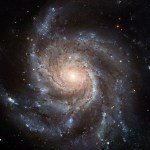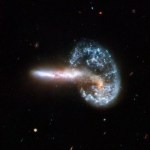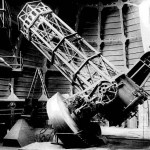Telescope
"If the stars should appear one night in a thousand years, how would men believe and adore, and preserve for many generations the remembrance of the city of God which had been shown!" -Ralph Waldo Emerson
If you're a regular here, you're no doubt more connected and interested in what lies beyond this world than most. But how often do you truly get to experience the wonder of a dark night sky for yourself? Like a great many of you, I live in the city, and in a particularly cloudy, overcast part of the world. During much of the year, it's far too cold to be out stargazing, and for perhaps the…
"This one will look like a jellybean," the session director warns us. "Or, you know, when you empty a hole punch? The circles of paper that fall out? One of those." She's talking about Neptune, and I am about to step, carefully, up a ladder painted industrial yellow and wheeled into place in front of the centenarian eyepiece of the 60" Hale telescope at Mt. Wilson Observatory, incidentally the very place where Edwin Hubble, in 1925, discovered that our galaxy was not the entirety of the Universe, and later, that our Universe was expanding.
A jellybean, a piece of confetti: it seems her…
"Forget it. I didn't have that thing inside me where I wanted to smash against somebody and watch them break. I was too sensitive for that and disliked being that sensitive." -Josh Brolin
How do you figure out what something is made of? You take it apart -- cracking it open if necessary -- and look inside. This is something we've been doing since... well, since before our ancestors were even human.
Images credit: Elisabetta Visalberghi.
For most things here on Earth, that's easy enough. If you wanted to go down to the smallest scales possible, however, it becomes harder and harder to "crack…
“At the last dim horizon, we search among ghostly errors of observations for landmarks that are scarcely more substantial. The search will continue. The urge is older than history. It is not satisfied and it will not be oppressed.” -Edwin Hubble
While new discoveries are made about the Universe, a new explorer finds its way on a foreign world, and the world bids farewell to a legend, my old favorite -- the Hubble Space Telescope -- keeps amazing us all.
Image credit: NASA / STS-125, Space Shuttle Atlantis, Ruffnax (Crew of STS-125).
Now more than 22 years into its continuing mission, this…
"I went into a clothing store, and the lady asked me what size I was. I said, 'Actual'. I'm not to scale." -Demitri Martin
When you look out at the Universe, what you can see is limited, at the most fundamental level, by the size of what you look with. This is why you can see dimmer objects at night -- when your pupils are dilated -- than you can when your pupils are constricted.
Image credit: National Institute of Health.
This same principle that applies to your eyes applies to telescopes as well. As telescopes have grown in size, so has our ability to see deeper into the Universe, as…
"This seems to be the law of progress in everything we do; it moves along a spiral rather than a perpendicular; we seem to be actually going out of the way, and yet it turns out that we were really moving upward all the time." -Frances Willard
As spring gives way to summer here in the Northern Hemisphere, one of the most beloved sights of the night sky becomes ever more prominent: the Big Dipper.
(Image credit: NASA, ESA, Z. Levay (STScI) and A. Fujii.)
These seven bright stars shine high above the horizon after sunset, and will continue to do so over the rest of the Spring and all Summer…
The service tower attached to the iconic floating egg atop the Institute's Koffler accelerator (the "spaceship" in the photo, left) has recently been graced with a charming, shiny silver skullcap - an observatory dome. Formally known as the Martin Kraar Observatory, it houses two telescopes, and it figured in two of our recent press items. We spoke with observatory director Ilan Manulis of the Davidson Institute of Science Education:
WSW: Tell us about the telescopes.
IM: The larger one is a 41 cm. (16 in.) telescope. Due to special optical properties, it has the power of a much longer…
By Dr. Franck Marchis
Planetary Astronomer at the Carl Sagan Center for the Study of Life in the Universe, SETI Institute
I mentioned in my previous post that we observed several known multiple asteroid systems during our last observing run with the W.M. Keck Observatory and its Adaptive Optics Systems. If you have been following my personal blogs and/or the scientific articles of our group (you are courageous...) you know this is the scientific topic which is taking most of my time recently. Today, as you can see if you explore our VOBAD database, we know 192 companions of asteroids. What I…
By Dr. Franck Marchis
Planetary Astronomer at the Carl Sagan Center for the Study of Life in the Universe, SETI Institute
I'd like to share the first of two blogs on observations of Io that we did using the Keck telescope and its Adaptive Optics (AO) system.
Similar to last year, my summer is busy with the REU (Research Experience for Undergraduates) students of the SETI Institute. I will write a specific post on two students who are working with me and their project in a few days.
I obtained telescope time at the end of June 2010 with the W.M. Keck II telescope and its Adaptive Optics system…
My grandmother suffered in her old age from macular degeneration, a common age-related eye disease that causes the center of your visual field (the macula) to gradually fritz out. As it affected her more and more, the font size in her emails ballooned to cartoonish sizes. She began walking with a cane, and needed a fancy electronic doo-dad to tell her when her cup of tea was full. By the end of her life, she was totally blind.
Watching my grandmother wink out from the world of seeing was tragic; the knowledge of macular degeneration's heredity terrifying. Relatives of those who have…
NASA loses a balloon in the outback
The Nuclear Compton Telescope (PI Boggs at UCB's SSL), a soft γ-ray telescope designed for balloon launch, observations in the stratosphere, and recovery, crashed because of a wind gust during an attempted launch in Australia earlier today.
ABC News (Oz) on youtube
NCT is an wide field imaging telescope with polarization capability.
Science goals were galactic nuclear emission lines for studies of nuclear synthesis in supernovae, and γ-ray polarization studies.
It flew last year out of the SFBF in New Mexico - guess they were going after southern…
(Thanks to Starts With A Bang! reader benhead.) The Hubble Space Telescope has released some beautiful images of colliding galaxies in a huge collection! Here are some of my favorites, with my very own names for them (real name in parentheses).
We'll start with the Glowing Arrow (Arp 148):
The Highway Windshield (NGC 6240)
The Flaming Splinter (NGC 6670):
And finally, I call this one "my new desktop wallpaper:"
I was going to write a whole bunch about this, but I have been beaten to the punch by Universe Today, Bad Astronomy, and Will Gater. I'll have to wake up earlier next time! In the…
I was doing a little research into the history of telescopes, and it was about a century ago that they finally realized how much more potential light-gathering power reflecting telescopes had as compared to the older refracting telescopes. On Mt. Wilson in California, astronomer George Ellery Hale and optician George Willis Ritchey (back then everybody was named George -- look it up!) were embarking on a program to build large reflecting telescopes as the wave-of-the-future of Astronomy.
But even before this telescope was operational, Hale and Ritchey were thinking of bigger and bigger…
Cameras, CCDs, prisms, grisms, etc., are all some of the instruments that can go on top of telescopes to help us see things better. We haven't really increased the size of telescopes so much as we have the quality and ability of the apparatus that go atop them. Take a look at various pictures I've stolen off the web, all taken by (avid) amateur astronomers in different years. The pictures are of M81 and M82, two galaxies in a group that make up possibly the nearest cluster of galaxies outside of the local group. (The closest is either the M81 group, the Centaurus group, or the IC 342 group.)…










